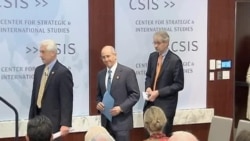Top trade officials reported progress, but no final deal, after negotiations this week in Singapore on the proposed Trans Pacific Partnership, or TPP. Advocates say the TPP would streamline commerce, boost the economy, and create jobs by coordinating regulations and removing non-tariff barriers for 12 Pacific nations from America to Vietnam. But U.S. critics say some of those "barriers" are hard-won protections for consumers, the environment, and workers.
The 12 nations haggling over the Trans Pacific Partnership include some of the world’s most robust economies, accounting for about one-third of global trade.
U. S. Congressman Charles Boustany says a lot of jobs already depend on trade among TPP nations, so more trade would mean more jobs.
“In 2011, trade exports and imports of goods and services with TPP countries supported an estimated 14.9 million American jobs," said Boustany.
The Pacific nations set to resume trade talks in January include Australia, Brunei, Chile, Japan, Malaysia, New Zealand, Peru, Singapore, Vietnam and the United States.
Disputes include access to Japan's market for U.S. autos and agricultural products, and haggling among other nations about protection for intellectual property.
U.S. Trade Representative Michael Froman hopes further negotiations will bring progress.
"We will continue to work with flexibility to finalize these text issues as well as market access issues," he said.
Experts say previous trade deals focused on cutting tariffs, which made it cheaper to move goods from one nation to another. Lower costs encouraged more trade. Tariffs are taxes on goods moving across borders.
TPP is an attempt to increase trade further by making regulations consistent from one nation to another, and getting rid of bureaucratic obstacles that take time, cost money, and slow trade, according to Washington attorney and former trade U. S. trade negotiator Jay Eizenstat.
"Non tariff barriers, behind the border barriers, and importantly, regulatory barriers, which as I have said impose at least as much ... and in many cases, more of a barrier to trade in goods and services, than the actual tariffs themselves," said Eizenstat.
But some of those regulations protect consumers, the financial system, the environment, patients, workers, and others from harm, according to Lori Wallach of the advocacy group Public Citizen.
"They label the fundamental environmental, health, safety standards on which our families rely as 'non-tariff trade barrier,"' she said.
Wallach says the TPP is more about politics than trade.
“A bunch of big corporations have used these trade agreements to try to get done through the back door of these secretive negotiations what they could not get through Congress," she said.
Opposition from some consumer and labor groups and many of President Obama's Democratic Party allies means a TPP deal faces an uncertain future in Washington. The agreement has to be ratified by many national legislatures, including the U.S. Congress.
TPP supporters hope to work out a legislative agreement to prevent last minute changes by Congress to any agreement that has been worked out with the TPP nations.
The 12 nations haggling over the Trans Pacific Partnership include some of the world’s most robust economies, accounting for about one-third of global trade.
U. S. Congressman Charles Boustany says a lot of jobs already depend on trade among TPP nations, so more trade would mean more jobs.
“In 2011, trade exports and imports of goods and services with TPP countries supported an estimated 14.9 million American jobs," said Boustany.
The Pacific nations set to resume trade talks in January include Australia, Brunei, Chile, Japan, Malaysia, New Zealand, Peru, Singapore, Vietnam and the United States.
Disputes include access to Japan's market for U.S. autos and agricultural products, and haggling among other nations about protection for intellectual property.
U.S. Trade Representative Michael Froman hopes further negotiations will bring progress.
"We will continue to work with flexibility to finalize these text issues as well as market access issues," he said.
Experts say previous trade deals focused on cutting tariffs, which made it cheaper to move goods from one nation to another. Lower costs encouraged more trade. Tariffs are taxes on goods moving across borders.
TPP is an attempt to increase trade further by making regulations consistent from one nation to another, and getting rid of bureaucratic obstacles that take time, cost money, and slow trade, according to Washington attorney and former trade U. S. trade negotiator Jay Eizenstat.
"Non tariff barriers, behind the border barriers, and importantly, regulatory barriers, which as I have said impose at least as much ... and in many cases, more of a barrier to trade in goods and services, than the actual tariffs themselves," said Eizenstat.
But some of those regulations protect consumers, the financial system, the environment, patients, workers, and others from harm, according to Lori Wallach of the advocacy group Public Citizen.
"They label the fundamental environmental, health, safety standards on which our families rely as 'non-tariff trade barrier,"' she said.
Wallach says the TPP is more about politics than trade.
“A bunch of big corporations have used these trade agreements to try to get done through the back door of these secretive negotiations what they could not get through Congress," she said.
Opposition from some consumer and labor groups and many of President Obama's Democratic Party allies means a TPP deal faces an uncertain future in Washington. The agreement has to be ratified by many national legislatures, including the U.S. Congress.
TPP supporters hope to work out a legislative agreement to prevent last minute changes by Congress to any agreement that has been worked out with the TPP nations.







